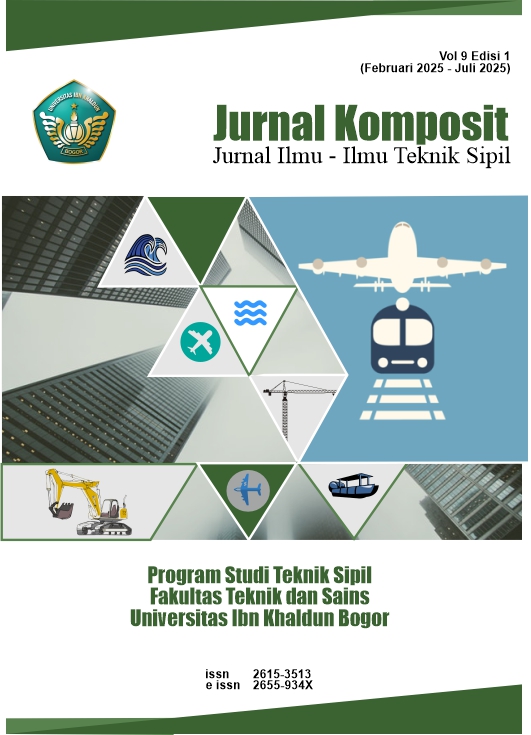Perbandingan Nilai Karakteristik Marshall untuk Campuran HRS-WC Menggunakan Material dari Sungai Inbate dan Sungai Bijaesahan
DOI:
https://doi.org/10.32832/komposit.v9i1.16663Keywords:
HRS-WC, Marshall characteristics, Inbate River, Bijaesahan RiverAbstract
Asphalt concrete has become the primary choice for road construction in Indonesia due to its elastic properties suitable for tropical regions. Hot Rolled Sheet-Wearing Course (HRS-WC), as one type of flexible pavement, plays a crucial role in supporting traffic from light to heavy loads. The objective of this study is to compare the Marshall characteristics of HRS-WC mixtures using materials from Inbate river and Bijaesahan river in the East Nusa Tenggara Province. The research method involved testing the material characteristics, mixing HRS-WC, and conducting Marshall method testing. The results indicate that the material from Inbate river exhibits better performance in stability and flexibility compared to material from Bijaesahan river. At the optimum asphalt content of 6.93%, the stability of Inbate river material was 1199.31 Kg, whereas Bijaesahan river was 957.68 Kg. Additionally, the flow of Inbate river material was 4.67 mm, while Bijaesahan river was 3.40 mm. Similar results were observed at the optimum asphalt content of 7.28%, with Inbate river showing stability of 1179.59 Kg and Bijaesahan river 944.16 Kg. The flow of Inbate river material was 4.84 mm, whereas Bijaesahan river was 3.48 mm. These findings demonstrate that material from Inbate river outperforms in stability and flexibility.
References
Badan Standardisasi Nasional. (1990). SNI 03-1968-1990 Metode Pengujian Tentang Analisis Saringan Agregat Halus dan Kasar. Jakarta: Badan Standarisasi Nasional. https://www.academia.edu/45603892/SNI_03_1968_1990_Analisa_Saringan_Agregat_Halus_dan_Kasar_
Badan Standardisasi Nasional. (1990). SNI 03-1969-1990 Metode Pengujian Tentang Berat Jenis dan Penyerapan Air. Jakarta: Badan Standarisasi Nasional. https://imsippoliban.wordpress.com/wp-content/uploads/2016/03/sni-03-1969-1990-metode-pengujian-berat-jenis-dan-penyerapan-air-agregat-kasar.pdf
Badan Standardisasi Nasional. (1990). SNI 03-1970-2008 Metode Pengujian Tentang Berat Jenis dan Penyerapan Air Agregat Halus. Jakarta: Badan Standarisasi Nasional. https://imsippoliban.wordpress.com/wp-content/uploads/2016/03/19968_sni-1970_2008.pdf
Badan Standardisasi Nasional. (1991). SNI 03-2417-1991 Metode Pengujian Keausan Agregat dengan Mesin Abrasi Los Angeles. Jakarta: Badan Standarisasi Nasional. https://imsippoliban.wordpress.com/wp-content/uploads/2016/03/sni-03-2417-1991-metode-pengujian-keausan-agregat-dengan-mesin-abrasi-los-angeles.pdf
Badan Standardisasi Nasional. (1991). SNI 15-2531-1991 Metode Pengujian Berat Jenis Semen Portland. Jakarta: Badan Standardisasi Nasional. https://www.scribd.com/doc/252696805/SNI-15-2531-1991-Pengujian-Berat-Jenis-Semen
Budi, A. F. S., Liem, F. N., & Alokabel, K. (2017). Studi Komparasi Pengaruh Variasi Penggunaan Nilai Konstanta Aspal Rencana terhadap Nilai Stabilitas pada Campuran Aspal Beton (HRS-WC) Terhadap Karakteristik Uji Marshall. Juteks (Jurnal Teknik Sipil), 2(1), 54–63. https://doi.org/10.32511/juteks.v2i1.124
Darmawan, I., Soediro, R., & Purwanto, D. (2003). Pengaruh Penggunaan Serbuk Genteng Sebagai Filler Terhadap Kinerja Campuran HRS-WC. PILAR, 12(1), 17–24. http://eprints.undip.ac.id/4581/
Dewi, S. H., Mildawati, R., & Nurhakim, A. (2021). Perbandingan Dua Jenis Agregat Daerah yang Berbeda terhadap Karakteristik Marshall Pada Aspal Porus. Sainstek, 9(1), 47–54. https://ejournal.sttp-yds.ac.id/index.php/js/article/view/33
Direktorat Jenderal Bina Marga, 2018. "Spesifikasi Umum 2018 Untuk Pekerjaan Konstruksi Jalan Dan Jembatan Revisi 2", Jakarta. https://kkjtj.pu.go.id/landing_page/pedoman-pemeriksaan-jembatan.pdf
Hermanus, G., Kaseke, O. H., & Jansen, F. (2015). Kajian Perbedaan Kinerja Campuran Beraspal Panas Antara Jenis Lapis Tipis Aspal Beton-lapis Aus (Hrs-wc) Bergradasi Senjang Dengan Yang Bergradasi Semi Senjang. Jurnal Sipil Statik, 3(4). https://ejournal.unsrat.ac.id/index.php/jss/article/view/8207
Khamid, A., & Izazi, M. A. (2019). Pengaruh Genangan Air Hujan terhadap Kinerja Campuran Aspal Concere-Wearing Course (AC-WC). Syntax Lit. J. Ilm. Indones, 4(7), 1–14. https://core.ac.uk/reader/268472530
Makin, M. L. A. M., Kalogo, E., & Bela, K. R. (2023). Pengaruh Variasi Jumlah Tumbukan terhadap Nilai Marshall Hasil Pemadatan pada Aspal HRS-WC secara Manual dan Elektrik. Eternitas: Jurnal Teknik Sipil, 2(2), 27–37. https://www.journal.unwira.ac.id/index.php/ETERNITAS/article/view/2444
Meilani, M., & Kurnia, R. (2019). Kajian Parameter Marshall Campuran Hangat Lataston (HRS-WC) Menggunakan Reclaimed Asphalt Pavement (RAP). RekaRacana: Jurnal Teknil Sipil, 5(4), 120. https://ejurnal.itenas.ac.id/index.php/rekaracana/article/view/3397
Nahyo, N., Sudarno, S., & Setiadji, B. H. (2015). Durabilitas Campuran Hot Rolled Sheet-Wearing Course (HRS-WC) Akibat Rendaman Menerus dan Berkala Air Rob. Jurnal Teknik Sipil Unaya, 1(2), 141–154. https://www.neliti.com/id/publications/143191/durabilitas-campuran-hot-rolled-sheet-wearing-course-hrs-wc-akibat-rendaman-mene
Putri, W. N., & Ritonga, E. D. E. (2021). Pengaruh Suhu Pemadatan Terhadap Stabilitas Campuran HRS-WC Dengan Filler Abu Sinabung. Jurnal Teknik Sipil, 2(01), 20–29. https://jim.teknokrat.ac.id/index.php/tekniksipil/article/view/792
Standart Nasional Indonesia. (2003). RSNI M-01-2003, Metode Pengujian Campuran Beraspal Panas dengan Alat Marshall. Badan Standarisasi Nasional, Jakarta. https://imsippoliban.wordpress.com/wp-content/uploads/2016/03/rsni-m-01-2003-metode-pengujian-campuran-beraspal-panas-dengan-alat-marshall.pdf
Weimintoro, W., Anggoro, N. D., & Aulia, R. (2021). Pengaruh Komposisi Agregat Terhadap Karakteristik Beton Aspal (AC-WC) Dengan Menggunakan Batuan Lokal Sungai Gung di Desa Danawarih Kecamatan Balapulang Kabupaten Tegal. Jurnal Teknik Sipil & Teknologi Konstruksi, 7(1), 15–26. http://jurnal.utu.ac.id/jtsipil/article/view/2546
Downloads
Published
How to Cite
Issue
Section
License
Copyright (c) 2025 Jurnal Komposit: Jurnal Ilmu-ilmu Teknik Sipil

This work is licensed under a Creative Commons Attribution-NonCommercial-ShareAlike 4.0 International License.
Authors who publish with this journal agree to the following terms (Penulis yang mengajukan publikasi artikel telah menyetujui hal berikut):
- Through this publication, the author agree to submit the copyright of article writing to Jurnal Komposit: Jurnal Ilmu-ilmu Teknik Sipil. This copyright submission takes the form of, but is not limited to: reproduction of the article and parts therein, including photographic reproductions; distribution of articles through printed and electronic documents; and translation of articles(Bahwa melalui publikasi ini, hak cipta penulisan artikel diserahkan kepada Jurnal Komposit: Jurnal Ilmu-ilmu Teknik Sipil. Penyerahan hak cipta ini berupa, namun tidak terbatas pada: perbanyakan artikel dan bagian di dalamnya, termasuk reproduksi fotografi; penyebarluasan artikel melalui dokumen cetak dan elektronik; serta penterjemahan artikel).
- The authors agree to the terms of the Copyright Notice, according to Creative Commons Attribution-NonCommercial-ShareAlike 4.0 International License., which will apply to this article if and when it is published by Jurnal Komposit: Jurnal Ilmu-ilmu Teknik Sipil. (Para penulis setuju dengan ketentuan Pemberitahuan Hak Cipta, sesuai dengan Lisensi Internasional Creative Commons Attribution-NonCommercial-ShareAlike 4.0., yang akan berlaku untuk artikel ini jika dan ketika diterbitkan oleh Jurnal Komposit: Jurnal Ilmu-ilmu Teknik Sipil).

This work is licensed under a Creative Commons Attribution-NonCommercial-ShareAlike 4.0 International License.



.png)










